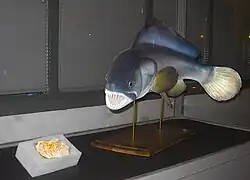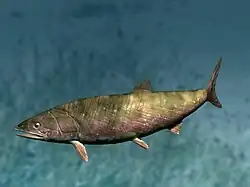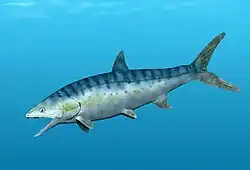Tomognathus
| Tomognathus Temporal range:
| |
|---|---|

| |
| Restoration of T. gigeri at Muséum départemental du Var (France) | |
| Scientific classification | |
| Kingdom: | Animalia |
| Phylum: | Chordata |
| Class: | Actinopterygii |
| Clade: | Halecomorphi |
| Order: | Amiiformes |
| Family: | † Jordan, 1923 |
| Genus: | † Dixon, 1850 |
| Species | |
| |
Tomognathus was a halecomorph fish related to the modern bowfin that lived in the Cretaceous Period. It was named by Dixon in 1850.
The name Tomognathus was also later applied to a modern species of ant by Mayr in 1861. But since the name was already taken it came instead to be classified as Harpagoxenus.
References
- Cavin, Lionel; Giner, Stephen (2012). "A large halecomorph fish (Actinopterygii: Holostei) from the Valanginian (Early Cretaceous) of southeast France". Cretaceous Research. 37: 201–208. Bibcode:2012CrRes..37..201C. doi:10.1016/j.cretres.2012.03.020.
- Forey, Peter L.; Patterson, Colin (2006). "Description and systematic relationships of †Tomognathus, an enigmatic fish from the English chalk". Journal of Systematic Palaeontology. 4 (2): 157–184. doi:10.1017/S1477201905001719. S2CID 86028273.

